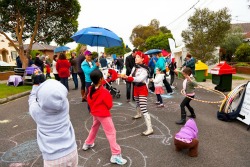Rossmoyne Street WAG
Building a sense of community in Thornbury
 |
 |
What is the setting?
Rossmoyne Street is a residential street in Melbourne’s northern suburb of Thornbury.
Who is involved?
The Rossmoyne Street Walkability Action Group or organisational committee consists of nine local residents supported by about 25 people representing local government, residents and community partners. We meet every four to six weeks for an ‘ideas harvest’, or when necessary to plan specific events.
How did the group come together?
In 2008, a small number of Rossmoyne Street residents organised a series of street parties to build a sense of community in the street. We believed that if residents felt part of a strong community, they would be more comfortable walking and spending time in their street, and would be better placed to advocate for improvements to local infrastructure.
Following this success, the street was selected as the location for a pilot program for work being done by our local council to address driver behaviour and walkability. The City of Darebin’s Drive with Your Heart program provided in-kind support so that we could continue to create a safer and better street for walkers by increasing social interaction. Council launched the pilot program with a street party in 2012, working closely with residents to plan and implement a very successful event.
Since then, other projects, also receiving council in-kind support, have included a street-long garage sale – the Rossmoyne Rummage – and a Christmas Carols parade. We have established a car share bay in the street and installed street furniture and planter boxes.
Following engagement with Victoria Walks on issues of neighbourhood walkability, we decided to become a Victoria Walks Walkability Action Group (WAG). We have a WAG page and a Facebook page.
How do you advocate for walkability?
We are building a socially connected neighbourhood by organising social events for street residents. Through this body, residents can lobby for change, and increased social interaction results in a more walkable neighbourhood.
As well as our web pages, we communicate using the local newspaper, the Rossmoyne Round-Up online newsletter, an e-list, letterbox drops and distribution of ‘I Heart Rossmoyne Street’ stickers.
What have you achieved and where to from here?
We have successfully built a local community centred around Rossmoyne Street. Street parties and the Rossmoyne Rummage have brought residents together, and Rossmoyne Street has become a place where social connection and walking are valued.
Support from our local council was another key achievement, recognising residents’ work, and providing human and financial resources.
Future events and activities to support Rossmoyne Street’s sense of community and promote walking and recreation in the area will include:
- pot-luck dinners and spontaneous events such as a game of Rounders
- a community walk with Friends of the Darebin Creek
- new street furniture such as vegetable planter boxes
- installation of car share bays, which supports our spirit of community sharing and reducing the impact of vehicles on the local streetscape
- lobbying for a pedestrian crossing.
What resources do you use?
Involvement with the City of Darebin’s Drive with Your Heart program allowed us to access local government funding and benefit from staff skills. We also benefit from the financial support of some local businesses.
Facebook helps us to communicate with a broader audience, and to connect with groups that have a similar interest.
A core group of highly skilled, organised and motivated members has made our work possible.
What has contributed to your success?
We consider people to be the key element of our success: it is people who see the potential for change and have the skills to make change happen. The initial convenors wanted people from varied backgrounds to participate in the group and its activities. They achieved this by organising events that appealed to a broad range of residents. Connecting with people in other groups with a similar interest helped the group to grow its network and skill base.
What are the challenges?
There have been no challenges, only opportunities.
What has kept you motivated?
Fun!
What advice can you offer about establishing a Walkability Action Group?
- Don’t try to achieve change on your own; work with others.
- Make the group social, about people and community.
- Be collaborative rather than adversarial.
- Build networks with existing groups with similar interests.
- Local government is valuable for obtaining human and financial resources.
- Document your community events.
- Connect with local businesses.
- Have fun!
Why should our neighbourhoods be more walkable?
Walkable environments are good for everyone: they provide the opportunity to increase physical and mental health, and are environmentally and socially sustainable. They value the idea of a ‘village’, where people participate in community life.